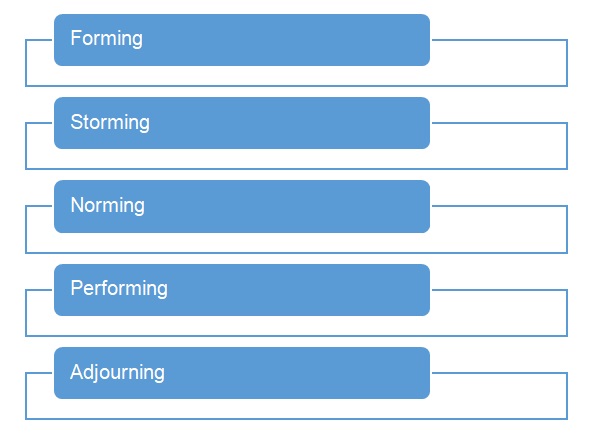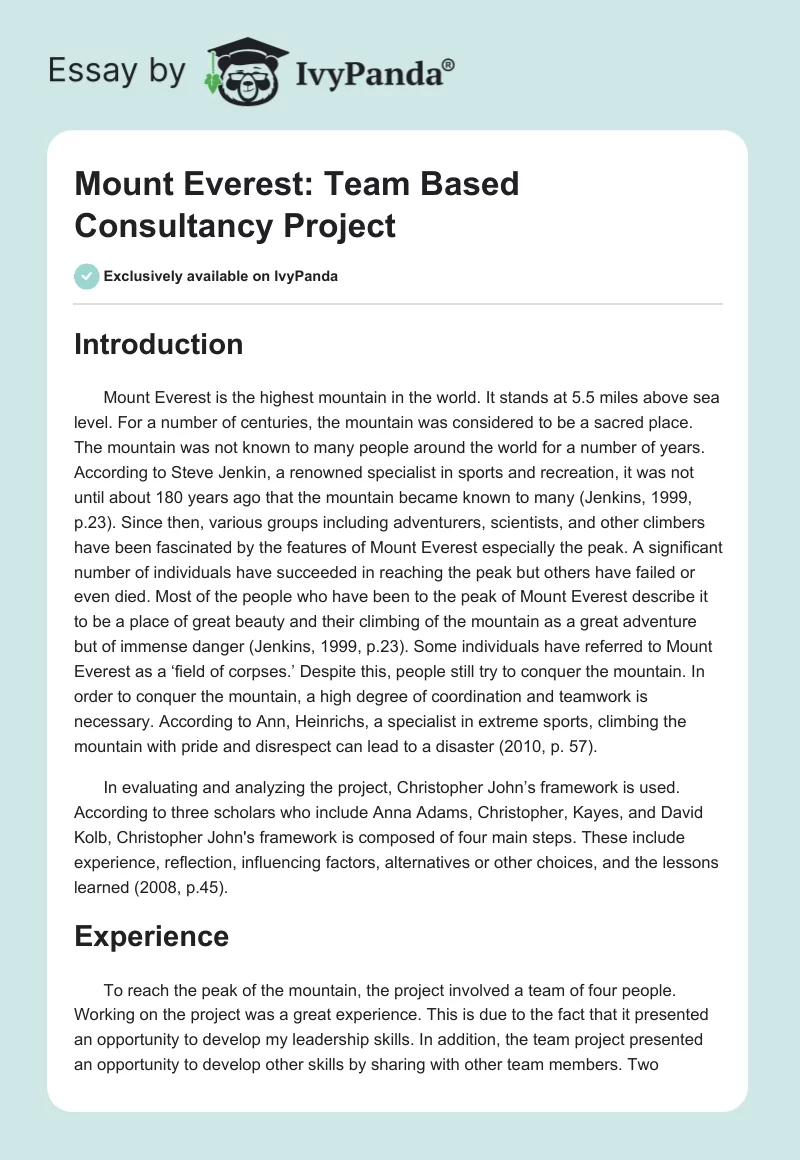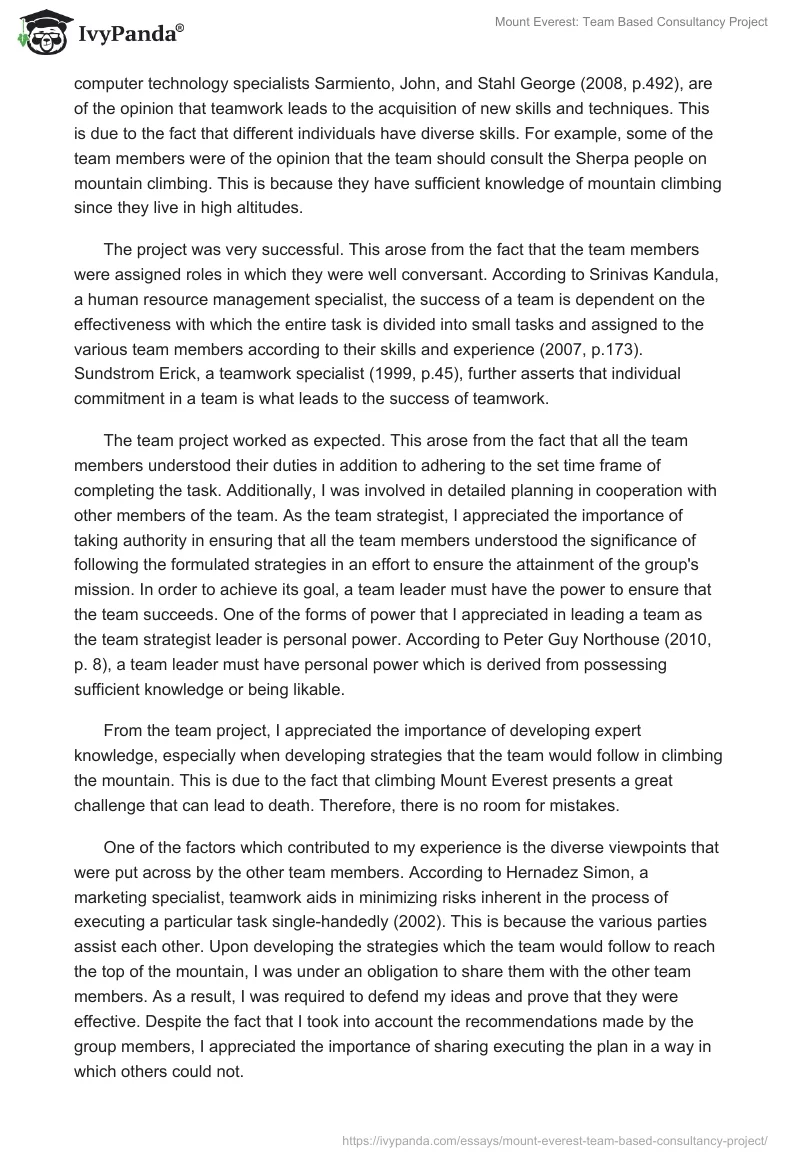Introduction
Mount Everest is the highest mountain in the world. It stands at 5.5 miles above sea level. For a number of centuries, the mountain was considered to be a sacred place. The mountain was not known to many people around the world for a number of years. According to Steve Jenkin, a renowned specialist in sports and recreation, it was not until about 180 years ago that the mountain became known to many (Jenkins, 1999, p.23). Since then, various groups including adventurers, scientists, and other climbers have been fascinated by the features of Mount Everest especially the peak. A significant number of individuals have succeeded in reaching the peak but others have failed or even died. Most of the people who have been to the peak of Mount Everest describe it to be a place of great beauty and their climbing of the mountain as a great adventure but of immense danger (Jenkins, 1999, p.23). Some individuals have referred to Mount Everest as a ‘field of corpses.’ Despite this, people still try to conquer the mountain. In order to conquer the mountain, a high degree of coordination and teamwork is necessary. According to Ann, Heinrichs, a specialist in extreme sports, climbing the mountain with pride and disrespect can lead to a disaster (2010, p. 57).
In evaluating and analyzing the project, Christopher John’s framework is used. According to three scholars who include Anna Adams, Christopher, Kayes, and David Kolb, Christopher John’s framework is composed of four main steps. These include experience, reflection, influencing factors, alternatives or other choices, and the lessons learned (2008, p.45).
Experience
To reach the peak of the mountain, the project involved a team of four people. Working on the project was a great experience. This is due to the fact that it presented an opportunity to develop my leadership skills. In addition, the team project presented an opportunity to develop other skills by sharing with other team members. Two computer technology specialists Sarmiento, John, and Stahl George (2008, p.492), are of the opinion that teamwork leads to the acquisition of new skills and techniques. This is due to the fact that different individuals have diverse skills. For example, some of the team members were of the opinion that the team should consult the Sherpa people on mountain climbing. This is because they have sufficient knowledge of mountain climbing since they live in high altitudes.
The project was very successful. This arose from the fact that the team members were assigned roles in which they were well conversant. According to Srinivas Kandula, a human resource management specialist, the success of a team is dependent on the effectiveness with which the entire task is divided into small tasks and assigned to the various team members according to their skills and experience (2007, p.173). Sundstrom Erick, a teamwork specialist (1999, p.45), further asserts that individual commitment in a team is what leads to the success of teamwork.
The team project worked as expected. This arose from the fact that all the team members understood their duties in addition to adhering to the set time frame of completing the task. Additionally, I was involved in detailed planning in cooperation with other members of the team. As the team strategist, I appreciated the importance of taking authority in ensuring that all the team members understood the significance of following the formulated strategies in an effort to ensure the attainment of the group’s mission. In order to achieve its goal, a team leader must have the power to ensure that the team succeeds. One of the forms of power that I appreciated in leading a team as the team strategist leader is personal power. According to Peter Guy Northouse (2010, p. 8), a team leader must have personal power which is derived from possessing sufficient knowledge or being likable.
From the team project, I appreciated the importance of developing expert knowledge, especially when developing strategies that the team would follow in climbing the mountain. This is due to the fact that climbing Mount Everest presents a great challenge that can lead to death. Therefore, there is no room for mistakes.
One of the factors which contributed to my experience is the diverse viewpoints that were put across by the other team members. According to Hernadez Simon, a marketing specialist, teamwork aids in minimizing risks inherent in the process of executing a particular task single-handedly (2002). This is because the various parties assist each other. Upon developing the strategies which the team would follow to reach the top of the mountain, I was under an obligation to share them with the other team members. As a result, I was required to defend my ideas and prove that they were effective. Despite the fact that I took into account the recommendations made by the group members, I appreciated the importance of sharing executing the plan in a way in which others could not.
Reflection
According to Kavita Singh (2010, p. 240), a specialist in organizational behavior, it is vital for individuals intended to form a team to conduct a concrete analysis of the task ahead. One of the ways through which this can be achieved is by taking into account Tuckman’s model of group development. The model consists of five stages which include forming, storming, norming, performing, and adjourning. In the forming stage, the available resources and the task at hand are taken into consideration (Singh, 2010, p. 240). At the storming stage, the group members clearly understand their roles. At the norming stage, Sarmiento, John, and Stahl, George (2008), group dynamic specialists assert that the group members start resolving their differences. In the performing stage, norms to guide the operation of the group are established. After the completion of the task, the group is disbanded. During the establishment of the group, these stages were followed.

According to Daniel Levi, a specialist in group dynamics, there are different challenges involved in the process of executing its roles. Hansen, Richard, a business and economist specialist (2006, p.11), it is important for the parties involved to adopt strategies that are effective. This means that the team must have a member who is knowledgeable in the formulation of strategies.
In the group, I played the role of a strategist assistant. For a number of years, I had been involved in a number of projects which made me appreciate the importance of formulating effective strategies. My role was to ensure that there were well-laid strategies to ensure that the group reached the top of the mountain. To ensure that the group was successful, the roles were clearly defined and divided amongst the group members. As a result, there was no overlapping of roles.
The group adopted my role. The decision to adopt the role arose from the realization of the challenges associated with climbing Mount Everest. In the process of formulating my strategies, I was guided by the inherent risk. According to two renowned professors from the University of Ottawa, Shaunna Burke and Terry Orlick, it takes approximately 2 months to reach the peak of the mountain. In addition, it is a dangerous task. According to Burke and Orlick (2007, p.43), approximately 300 people have died in an effort to reach the peak. Their death has resulted from a number of factors such as loss of will, fatigue, extreme weather conditions, loss of focus, high altitude sickness, and injury. Considering the inherent risk, the group came to a consensus that it was necessary for effective strategies to be put into place.
According to Sullivan (1998, p.341), the success of a team is dependent on its composition. Additionally, a team must have members with different skills and abilities to undertake the various tasks. Members of a particular team possess different personalities. These personalities include competitors, cooperators, and individualists. Competitors are mainly concerned with their individual success rather than that of a group. On the other hand, individualists are focused on attaining their personal goals. This means that the success or lack thereof is not a concern to competitors.
The cooperators are mainly focused on attaining the goals of the team. Additionally, cooperators are concerned with the outcome of their actions in addition to that of others. The dominant personality which characterizes our group is cooperators.
An alternative course of action
In addition to the basic strategies necessary to reach the peak of the mountain safely, I also considered the importance of preparing the team members mentally. One of the strategies which I incorporated is the use of imagery. I indicated to the team members the importance of imagining themselves at the peak of the mountain. This was necessary for preparing them to be acquainted with the difficult phases of climbing the mountain.
I also considered the importance of inquiring from the other team members about their thoughts and feelings on the expeditions. For example, considering the opinion of the team members aided in identifying other obstacles that might have been overlooked. For example, some of the issues which the team members raised relate to oxygen depletion, conflict with other climbers, and exhaustion. By considering the opinion of other team members I was able to avert possible conflicts that might limit the success of the team.
In setting the strategies, I also considered that it would be paramount to set short term goals to ensure that the success of the event. Considering the challenging task of climbing the mountain, short term goals are necessary. This arises from the fact that it would aid them in remaining focused. According to Forrester, William and Tashchian, Adam (2006, p.45), setting short term goals play a vital role in the process of attaining the desired goal. This is due to the fact that it eliminates possibilities of the team members from being overwhelmed by the immense size of the intended goal (William & Adam, 2006, p.45). The team members would be assigned roles according to their personalities. I would use the Belbin model in determining the main roles. According to the Belbin model, a team is composed of different roles arising from their personalities (Select Knowledge, 2007, p. 32). The main roles are illustrated in the chart below.
Source: Select Knowledge.
I would also consider training the team members on some of the necessary skills when climbing the mountain. Some of these strategies relate to safety so as to avoid injuries. This is due to the fact that the safety of the group is not only dependent on the group but also on individual responsibilities. Each of the members had to ensure that they adhere to the set safety regulations. Additionally, I would also consider training the team members so as to acclimatize them with a high attitude. These techniques would play a vital role in ensuring that the climbing expedition is successful.
Learning
The project presented me with an opportunity to understand the issues which are necessary for the success of the team. These skills can be of great importance in the business environment. According to two organizational behavior specialists, Belal Kaifi and Sulaiman Noori (2010, p.88), teams are an essential component in the success of the business, especially in the modern world. Teams are very effective in solving organizational challenges. Some of the issues I appreciated relate to the importance of all the team members understanding the mission, vision, and purpose of the team. Kaifi and Noori (2010, p.88) further assert that understanding the goals provide a sense of direction amongst all the team members. The project also provided an opportunity to appreciate the importance of translating the teams’ goals into specific, measurable, accurate, reliable, and time bound objectives. According to Glenn Parker (2009, p. 3), breaking down the team’s goals into short term objectives increases the probability of a team succeeding. This is of great importance in the future when formulating objectives aimed at achieving specific goals.
Upon breaking down the overall goal into a number of tasks, the various team members should be assigned their respective roles in accordance with their skills and expertise. Michaelsen, Lincoln, Bauman Knight, and Fink, Lawrence who are renowned scholars in human resource management are of the opinion that the team leader must clarify the roles to avoid conflict of interest (2004, p. 45).
From the project, I also appreciated the importance of empowering team members in their roles. As a result, they can be able to make decisions without any influence. The resultant effect is a high degree of efficiency. The project also gave me an opportunity to appreciate the importance of selecting the right people in forming a team. This arises from the fact that the attainment of the teams’ goal is dependent on all the team members. This is further explained by Kaifi and Noori (2010, p. 99) who are of the opinion that, the success of a team is affected by the existing social cohesion. As a result, all members of the team must share their skills, capabilities, and expertise with others. In addition, selecting individuals with a common goal aids in creating an environment conducive to the operation of the team. This arises from the fact that all the team members will enjoy working with each other.
From the project, I also appreciated the importance of openness. According to Nath, Daniel (2008), a team is composed of individuals with different viewpoints and ideas. This might result in conflicts between team members. To avert this, team members must be ready to listen to the opinions of the other group members.
In addition, I also appreciated the importance of setting a timeframe in an effort to achieve a certain goal. The resultant effect is that the intended benefits are achieved.
Conclusion
The team project was a great opportunity for me to understand the importance of working as a team. For example, I appreciated the importance of role clarification amongst the various team members. This is due to the fact that the success of the teams is dependent on the contribution of all the team members. Additionally, clarification of roles aids in averting conflict of interest amongst the team members. After assigning team roles, the various parties should be given the authority to make their own decisions. They should not be restrained from acting in any way. The existence of freedom of action will ensure that the team members are motivated in their roles. From the project, I developed a comprehensive understanding of sharing and respecting the opinions of other team members.
Reference List
Adams, A. Kayes, C. & Kolb, D. 2008. Experiential learning in teams. New York: Case Western Reserve University.
Burke, S. & Orlick, T. Mental strategies of elite Mount Everest climbers. Journal of Excellence. Vol. 3, Issue 8, pp. 42-67. Ottawa: Ottawa University.
Clayton, M. & Hailstone, P., 2009. The management models pocketbook. Alresford: Management Pocketbooks.
Glenn, P., 2009. Teamwork 20 steps to success. New York: Human Resource Development Pr.
Hansen, R., 2006. Benefits of and problems with student’s teams: suggestions for improving team projects. Journal of Education for Business. Vol. 82, issue 1, pp. 11-19.
Heinrich, A., 2010. Mount Everest. New York: Marshall Cavendish Benchmark. Hernadez, S., 2002. Team learning in a marketing principles course: cooperative
structures that facilitate active learning and higher-level thinking. Journal of Marketing Education. Vol. 24, issue 1, pp. 73-85.
Forrester, W. & Tashchian, A., 2006. Modeling relationship between cohesion and performance in student workgroup. International Journal of Management. Vol. 23, issue 3, pp. 458-464.
Jenkins, S., 1999. The top of the world: climbing Mount Everest. Boston: Houghton Mifflin Co.
Kaifi, B. & Noori, S., 2007. Organizational behavior: a study on managers, employees and teams. Journal of Management Policy and practice. Vol. 12, issue 1. California: University of California.
Kandula, S., 2007. Human resource management in practice: With 300 models techniques and tools. New Delhi: Prentice-Hall of India.
Kavita, S., 2010. Organizational behavior: text and cases. Chandigarh: Upper Saddle River.
Levi, D., 2011. Group dynamics for teams. Los Angeles: Sage.
Michaelsen, L., Bauman, K. A. & Fink, L., 2004. Team-based learning: A transformative use of small groups in college teaching. Sterling, VA: Stylus Publishing.
Nath, D., 2008. Building trust and cohesiveness in a leadership team: A practitioner’s perspective. Reflection. Vol. 9, issue 1, pp. 24-36.
Northouse, G., 2010. Leadership: theory and practice. Thousand Oaks: Sage Publications.
Sarmiento, J. W. & Stahl, G., 2008. Group creativity in interaction: Collaborative referencing, remembering, and bridging. International Journal of Human-Computer Interaction. Vol. 24, issue no. 5, pp. 492-504.
Select Knowledge. 2007. Managing teams. New York: Select Knowledge.
Sundstrom, E., 1999. Supporting work team effectiveness. San Francisco: Jossey-Bass.
Sullivan, P., 1998. Profiting from intellectual capital: extracting value from innovation. New York: John Wiley.
Williams, S. K., & Anderson, J. S., 2008. Teams lab: Promoting effective teamwork in operations management classes. Decision Sciences Journal of Innovative Education. Vol. 6. Issue no. 1, pp. 159-166.


